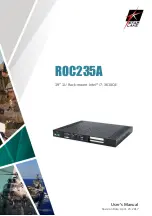
2-17
Installation
2Unpacking to Installation
(2) RH-3FRHR series
Fig.2-7 : Installation dimensions (RH-3FRHR series)
1) The robot installation surface has been machine finished. Use the installation holes (4-φ9) opened at the
four corners of the base, and securely fix the robot with the enclosed installation bolts (hexagon socket
bolts).
2) Install the robot on a level surface.
3) It is recommended that the surface roughness of the table onto which the robot is to be installed by Rz25 or
more. If the installation surface is rough, the contact with the table will be poor, and positional deviation
could occur when the robot moves.
4) When installing, use a common table to prevent the position of the devices and jigs subject to robot work
from deviating.
5) The installation surface must have sufficient strength to withstand the arm reaction during operation, and
resistance against deformation and vibration caused by the static (dynamic) load of the robot arm and
peripheral devices, etc.
6) If you operate the robot at a high speed, reaction forces are applied to the installation stand by the robot's
operation. Make sure that the installation stand on which the robot is placed has sufficient strength and
rigidity.
shows the maximum reaction force (design values) that may be applied to an installation
stand. Please use these values as reference when designing the installation stand.
㻾㼦㻞㻡
㻾㼦㻞㻡
㻟㻢㻜
㻟㻠㻜
㻝㻤㻜㻛㻞㻜㻜
㻝㻢㻜
㻔㻵㼚㼟㼠㼍㼘㼘㼍㼠㼕㼛㼚㻌㼞㼑㼒㼑㼞㼑㼚㼏㼑㻕
㻔㻵㼚㼟㼠㼍㼘㼘㼍㼠㼕㼛㼚㻌 㼞㼑㼒㼑㼞㼑㼚㼏㼑㻕
㻠㻙䃥㻥
㼕㼚㼟㼠㼍㼘㼘㼍㼠㼕㼛㼚㻌㼔㼛㼘㼑
㻹㼍㼕㼚㼠㼑㼚㼍㼚㼏㼑㻌㼟㼜㼍㼏㼑
㻞㻙㻹㻝㻞㻌㼔㼛㼘㼑㻌㼒㼛㼞㻌㼔㼍㼚㼓㼕㼚㼓㻌㼠㼛㼛㼘㼟
㻠㻙㻹㻤㻌㼔㼛㼘㼑㻌㼒㼛㼞㻌㼖㼍㼏㼗㻙㼡㼜
㻵㼚㼟㼠㼍㼘㼘㼍㼠㼕㼛㼚㻌㼟㼠㼍㼓㼑
㻔㼑㼤㼍㼙㼜㼘㼑㻕
㻺㼛㼠㼑㻌㻝㻕
㻺㼛㼠㼑㻌㻞㻕
㻔㻤㻜㻕
㻟㻟㻢
㻟㻝㻜
㻞㻟㻜
㻟㻜㻜
㻡㻜㻜
㻤㻞
㻹㼍㼕㼚㼠㼑㼚㼍㼚㼏㼑㻌㼟㼜㼍㼏㼑
F
V
M
T
F
H
M
L
F
H
M
L
F
H
F
H
F
V
Note1) General environment type:
180mm
Clean/waterproof specification:
200mm
Note2) The interference of installation bolt
and No.1 arm may occur depending on
the size of installation stage. Take care
against interference of installation bolt,
such as inserting the installation bolt
from the bottom.
















































